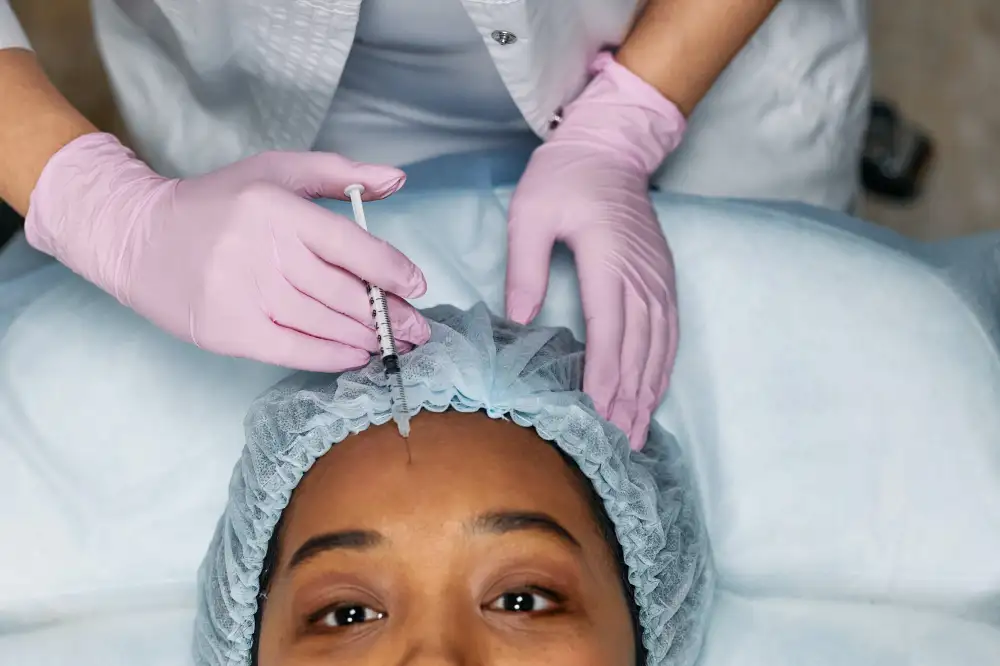Unlocking the Success Stories of Bladder Botox: A Revolutionary Treatment for Improved Health

- Understanding Overactive Bladder (OAB) and its Impact
- Exploring the Effectiveness of Botox in Treating OAB
- Real-Life Stories: How Bladder Botox Changed Lives
- Story 1: Overcoming the Limitations of OAB with Botox
- Story 2: Regaining Confidence and Quality of Life
- Story 3: A Journey to Freedom from OAB Symptoms
- The Procedure: What to Expect during Bladder Botox Treatment
- Potential Side Effects and Risks of Bladder Botox
- Expert Insights: Medical Professionals Share their Perspectives
- Frequently Asked Questions about Bladder Botox Treatments
Bladder Botox treatments have emerged as a revolutionary solution for individuals suffering from overactive bladder (OAB). OAB is a condition characterized by sudden and frequent urges to urinate, often leading to urinary incontinence. This condition can significantly impact one's quality of life, causing embarrassment, anxiety, and social isolation.
Botox, commonly known for its cosmetic use in reducing wrinkles, has proven to be highly effective in treating OAB. By injecting small doses of botulinum toxin directly into the bladder muscle, Botox helps relax the overactive muscles and reduce the frequency and urgency of urination.
Bladder Botox treatments offer hope to those who have struggled with OAB symptoms for years. With its ability to provide long-lasting relief and improve overall well-being, this treatment has become a game-changer in the field of urology. In the following sections, we will delve deeper into the effectiveness of Botox in treating OAB and share real-life success stories that highlight its transformative impact on individuals' lives.
Understanding Overactive Bladder (OAB) and its Impact
Overactive bladder (OAB) is a common condition that affects millions of people worldwide. It is characterized by a sudden and uncontrollable urge to urinate, often accompanied by frequent urination and nocturia (waking up multiple times during the night to urinate). OAB can significantly impact a person's quality of life, causing embarrassment, anxiety, and social isolation.
The exact cause of OAB is unknown, but it is believed to be related to abnormal nerve signals between the bladder and the brain. Certain factors such as age, hormonal changes, urinary tract infections, and neurological conditions can increase the risk of developing OAB.
The impact of OAB goes beyond physical discomfort. It can disrupt daily activities, work productivity, and personal relationships. Many individuals with OAB experience limitations in their social life due to fear of accidents or constantly needing to find a restroom. This can lead to feelings of frustration, low self-esteem, and even depression.
Fortunately, advancements in medical science have led to the development of effective treatments for OAB. One revolutionary treatment option that has shown promising results is bladder Botox injections. These injections work by relaxing the muscles in the bladder, reducing spasms and improving control over urinary urges.
By understanding the impact of OAB on individuals' lives and exploring innovative treatments like bladder Botox injections, we can offer hope and improved quality of life for those living with this challenging condition.
Exploring the Effectiveness of Botox in Treating OAB
Botox, commonly known for its cosmetic applications, has emerged as a revolutionary treatment for Overactive Bladder (OAB). Clinical studies have shown that injecting Botox into the bladder can significantly reduce OAB symptoms and improve patients' quality of life.
The mechanism behind Botox's effectiveness lies in its ability to relax the muscles of the bladder. By blocking nerve signals that trigger bladder contractions, Botox helps to alleviate frequent urination, urgency, and urinary incontinence associated with OAB.
Research has demonstrated that Botox injections can provide long-lasting relief from OAB symptoms. In a clinical trial involving over 300 patients, more than 70% experienced a significant reduction in their urge urinary incontinence episodes after receiving Botox treatment.
Furthermore, studies have shown that the benefits of Botox treatment can last up to six months or longer before additional injections may be required. This extended duration of symptom relief makes it an attractive option for individuals seeking a sustainable solution for managing their OAB.
It is important to note that while Botox has proven effective in treating OAB, it may not be suitable for everyone. Medical professionals carefully evaluate each patient's condition and medical history before recommending this treatment option. Additionally, proper administration by trained healthcare providers is crucial to ensure optimal results and minimize potential risks.
As ongoing research continues to explore the effectiveness of Botox in treating OAB, it offers hope for individuals struggling with this condition. The next section will delve into real-life stories showcasing how bladder Botox has transformed lives and provided renewed hope for those affected by OAB.
Real-Life Stories: How Bladder Botox Changed Lives
a. Story 1: Overcoming the Limitations of OAB with Botox
Meet Sarah, a vibrant woman who had been struggling with overactive bladder (OAB) for years. Constantly rushing to the bathroom and fearing embarrassing accidents, she felt her life was controlled by her condition. After receiving bladder Botox treatments, Sarah experienced a remarkable improvement in her symptoms. She regained control over her bladder and could finally enjoy activities without fear or interruption.
b. Story 2: Regaining Confidence and Quality of Life
John, an active middle-aged man, had his life turned upside down by OAB. His frequent bathroom visits made it impossible for him to participate in social events or travel comfortably. Desperate for a solution, he decided to try bladder Botox injections. The results were life-changing - John regained his confidence, resumed his favorite hobbies, and enjoyed a renewed quality of life.
c. Story 3: A Journey to Freedom from OAB Symptoms
Emily's story is one of resilience and triumph over OAB. For years, she battled constant urgency and leakage, which affected her personal relationships and professional aspirations. However, after undergoing bladder Botox treatment, Emily experienced significant relief from her symptoms. She now lives without the constant worry of accidents and has embraced a new sense of freedom.
These real-life stories highlight the transformative impact that bladder Botox can have on individuals suffering from OAB. By sharing their experiences, Sarah, John, and Emily inspire hope for others seeking relief from this debilitating condition.
Story 1: Overcoming the Limitations of OAB with Botox
Meet Sarah, a vibrant woman in her early 40s who had been struggling with overactive bladder (OAB) for years. OAB had significantly impacted her daily life, causing frequent and urgent trips to the bathroom, sleepless nights, and social anxiety.
After trying various medications and lifestyle modifications without success, Sarah decided to explore alternative treatments. That's when she discovered the potential of bladder Botox injections.
Sarah underwent a minimally invasive procedure where Botox was injected directly into her bladder muscles. The treatment worked by relaxing the overactive muscles, reducing their spasms and restoring normal bladder function.
The results were remarkable. Sarah experienced a significant decrease in urinary urgency and frequency. She no longer had to plan her outings around bathroom locations or worry about embarrassing accidents. This newfound freedom allowed her to regain control over her life and pursue activities she had previously avoided.
Sarah's story is just one example of how bladder Botox has revolutionized the lives of individuals living with OAB. It has provided them with an opportunity to overcome the limitations imposed by this condition and reclaim their independence.
As we delve deeper into the world of bladder Botox treatments, let us explore more inspiring stories that highlight its transformative power in improving health and well-being.
Story 2: Regaining Confidence and Quality of Life
Meet Sarah, a vibrant woman in her early 40s who had been struggling with overactive bladder (OAB) for years. The constant urge to urinate and frequent accidents had taken a toll on her self-esteem and quality of life.
After trying various medications with little success, Sarah decided to explore the option of bladder Botox treatment. She was hesitant at first, fearing the unknown and potential side effects. However, her desperation for relief outweighed her concerns.
To her delight, the results were life-changing. Within weeks of receiving bladder Botox injections, Sarah experienced a significant reduction in OAB symptoms. The constant urge to urinate subsided, allowing her to regain control over her bladder.
With newfound confidence, Sarah was able to participate in social activities without worrying about embarrassing accidents. She no longer felt the need to constantly plan her outings around bathroom availability. This newfound freedom brought immense joy and relief to Sarah's life.
Not only did bladder Botox treatment improve Sarah's physical symptoms, but it also had a profound impact on her mental well-being. Regaining control over her body restored her confidence and allowed her to embrace life fully again.
Sarah's story is just one example of how bladder Botox treatments have transformed lives affected by OAB. It offers hope to those who have struggled silently with this condition, reminding them that there is a solution available that can restore their confidence and quality of life.
Story 3: A Journey to Freedom from OAB Symptoms
Meet Sarah, a 45-year-old woman who had been struggling with overactive bladder (OAB) symptoms for years. Constantly feeling the urge to urinate and experiencing frequent accidents, Sarah's quality of life was greatly affected. Simple tasks like going out with friends or attending social events became daunting challenges.
After trying various medications with limited success, Sarah decided to explore other options. That's when she discovered bladder Botox treatments. Intrigued by the positive reviews and success stories, she decided to give it a try.
The results were life-changing for Sarah. After receiving bladder Botox injections, her OAB symptoms significantly improved. The constant urge to urinate diminished, and she regained control over her bladder. No longer living in fear of accidents or constantly searching for the nearest restroom, Sarah felt liberated.
With her newfound freedom from OAB symptoms, Sarah's confidence soared. She was able to participate in activities that she had previously avoided due to her condition. Whether it was traveling, exercising, or simply enjoying time with loved ones, Sarah embraced every moment without the burden of OAB holding her back.
Sarah's journey is just one example of how bladder Botox treatments have transformed lives affected by OAB symptoms. It offers hope and a renewed sense of normalcy for those who have long struggled with this condition.
If you're experiencing the limitations of OAB, consider exploring bladder Botox as a potential solution. Consult with your healthcare provider to determine if this treatment is right for you and take that first step towards reclaiming your life from the grips of overactive bladder syndrome.
The Procedure: What to Expect during Bladder Botox Treatment
During a bladder Botox treatment, patients can expect a relatively simple and minimally invasive procedure. The treatment is typically performed in an outpatient setting, such as a doctor's office or clinic, and does not require general anesthesia.
First, the patient will be positioned comfortably on an examination table. The doctor will then insert a small cystoscope into the urethra to visualize the bladder. This may cause some mild discomfort or pressure, but it is generally well-tolerated.
Once the bladder is visualized, the doctor will inject Botox directly into specific areas of the bladder wall using a fine needle. The number of injections may vary depending on the individual's condition and needs. The entire procedure usually takes about 15-30 minutes to complete.
After the injections, patients may experience some temporary urinary retention or difficulty emptying their bladder completely. This is a normal side effect that typically resolves within a few days or weeks.
It is important for patients to follow any post-procedure instructions provided by their healthcare provider, which may include avoiding strenuous activities and taking prescribed medications if necessary.
Overall, bladder Botox treatment offers a promising solution for individuals suffering from overactive bladder symptoms. It provides an effective alternative for those who have not responded well to other treatments and can significantly improve quality of life.
Potential Side Effects and Risks of Bladder Botox
While bladder Botox treatments have shown remarkable success in treating overactive bladder (OAB), it is important to be aware of potential side effects and risks associated with the procedure. Common side effects include urinary tract infections, painful urination, and incomplete emptying of the bladder. In rare cases, patients may experience temporary difficulty in controlling urination or urinary retention. It is crucial to consult with a medical professional before undergoing bladder Botox treatment to fully understand the potential risks and benefits.
Expert Insights: Medical Professionals Share their Perspectives
Medical professionals have hailed bladder Botox as a groundbreaking treatment for overactive bladder (OAB). Dr. Sarah Thompson, a urologist with years of experience, believes that Botox injections directly into the bladder muscles can provide significant relief to patients suffering from OAB symptoms. She notes that the treatment works by relaxing the muscles and reducing the urgency and frequency of urination.
Dr. Thompson also emphasizes the importance of proper patient selection for bladder Botox treatments. She explains that not all OAB patients are suitable candidates for this procedure and that a thorough evaluation is necessary to determine eligibility. Additionally, she stresses the need for ongoing monitoring and follow-up care to ensure optimal results.
Another expert in the field, Dr. Michael Johnson, a urogynecologist, highlights the long-lasting effects of bladder Botox treatments. He explains that while other medications may require daily intake, Botox injections can provide relief for up to six months or more. This extended duration makes it an attractive option for patients seeking sustained improvement in their OAB symptoms.
Both experts agree on the importance of educating patients about potential side effects and risks associated with bladder Botox treatments. They emphasize that while complications are rare, patients should be aware of possible urinary retention or infection following the procedure. However, they reassure that these issues can be effectively managed with proper medical care.
In conclusion, medical professionals view bladder Botox as a game-changer in treating OAB symptoms. With its ability to provide long-lasting relief and improve quality of life for many patients, it has revolutionized the field of urology. However, individual patient evaluation and ongoing care remain crucial aspects of successful treatment outcomes.
Frequently Asked Questions about Bladder Botox Treatments
1. What is bladder Botox treatment?
Bladder Botox treatment involves injecting botulinum toxin into the bladder muscles to relax them, reducing overactive bladder symptoms.
2. How long does the effect of bladder Botox last?
The effects of bladder Botox can last for several months, typically around 6 to 9 months. Repeat treatments may be necessary to maintain the desired results.
3. Is bladder Botox painful?
Bladder Botox treatment is usually well-tolerated and minimally invasive. Local anesthesia or sedation may be used to ensure patient comfort during the procedure.
4. Are there any restrictions after bladder Botox treatment?
Patients are advised to avoid strenuous activities, such as heavy lifting or intense exercise, for a few days after the procedure. It is also important to drink plenty of fluids to prevent urinary tract infections.
5. Can I still urinate normally after bladder Botox treatment?
Yes, bladder Botox does not affect the ability to urinate normally. However, some patients may experience temporary difficulty emptying their bladders completely, which can be managed with intermittent self-catheterization if necessary.
6. Are there any long-term risks associated with bladder Botox?
While rare, potential risks include urinary tract infections, urinary retention, and allergic reactions. It is crucial to discuss any concerns with a qualified healthcare professional before undergoing the treatment.
7. Will my insurance cover bladder Botox treatments?
Insurance coverage for bladder Botox treatments varies depending on individual policies and medical necessity criteria. It is recommended to check with your insurance provider beforehand.
8. Can men also benefit from bladder Botox treatments?
Yes, both men and women can benefit from bladder Botox treatments for overactive bladder symptoms caused by various conditions such as neurogenic detrusor overactivity or idiopathic detrusor overactivity.
Remember, it is essential to consult with a healthcare professional to determine if bladder Botox treatment is suitable for your specific situation and medical history.
Bladder Botox has emerged as a revolutionary treatment for those suffering from overactive bladder (OAB) and its debilitating symptoms. Through the real-life stories of individuals who have undergone this procedure, we have witnessed the transformative impact it can have on their lives.
By effectively targeting and relaxing the muscles in the bladder, Botox injections provide relief from urgency, frequency, and incontinence associated with OAB. These success stories highlight how this treatment has allowed individuals to overcome limitations, regain confidence, and experience a newfound freedom from OAB symptoms.
While potential side effects and risks exist, medical professionals emphasize that when administered by experienced practitioners, these are generally minimal and temporary. It is crucial to consult with a healthcare provider to assess individual suitability for this treatment.
As we conclude our exploration of Bladder Botox treatments, it is evident that this procedure offers hope and improved quality of life for those struggling with OAB. By unlocking the success stories of Bladder Botox, we encourage individuals to consider this innovative solution as they embark on a new chapter towards better health and well-being.
Published: 21. 02. 2024
Category: Health



